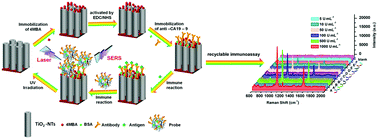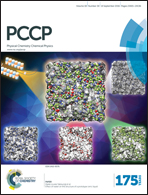Bifunctional 4MBA mediated recyclable SERS-based immunoassay induced by photocatalytic activity of TiO2 nanotube arrays
Abstract
We first report here a novel recyclable surface-enhanced Raman scattering (SERS)-based immunoassay via the photocatalytic ability of anatase titania nanotube (TiO2-NT) arrays. In this immunoassay, an immune probe was realized by immobilizing anti-CA19-9 onto Ag@SiO2@Ag three core–shell nanoparticles (TCSNPs), which showed a much higher SERS activity than bare Ag NPs with an enhancement ratio of 1.75. Then, the vertically oriented TiO2-NT immune substrate was synthesized by ultra-fast anodic oxidation of flexible titanium foils and functionalised with 4-mercaptobenzoic acid (4MBA) molecules to link them with anti-CA19-9. The immunoassay using the above immune probe and the substrate exhibited a wide linear range from 1000 to 0.5 U mL−1 and a low detection limit of 0.5 U mL−1 for CA19-9 due to the excellent SERS performance of Ag@SiO2@Ag TCSNPs. More importantly, the linkage between TiO2-NTs and 4MBA was destroyed by catalyzing 4MBA into 4-sulfobenzoate upon UV irradiation in O2-saturated water. The target antigen and the immune probe were simultaneously removed leading to a recyclable immunoassay and a detection limit of 5 U mL−1 was achieved after six cycles. The simplicity and versatility of this strategy may bridge the technology gap between academia and practical detection, which makes it promising for clinical SERS-based immunoassay.


 Please wait while we load your content...
Please wait while we load your content...